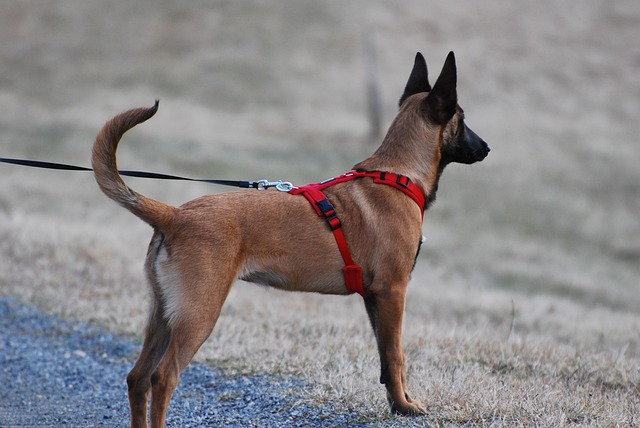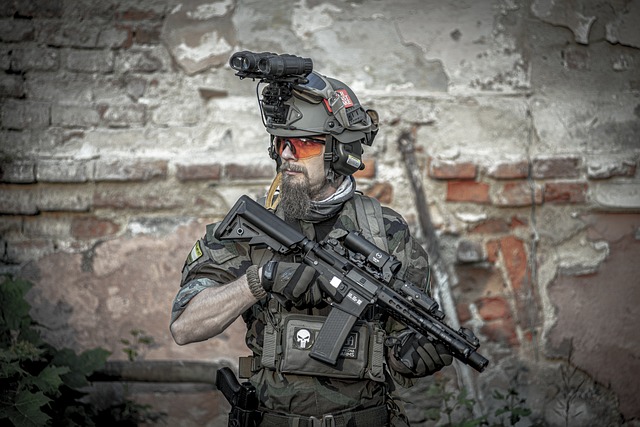A tactical dog harness is a specialized equipment designed for active dogs and their owners, prioritizing safety, comfort, and control during outdoor activities. Crafted from durable materials like robust nylon or synthetic leather, these harnesses feature reinforced stitching, quick-release buckles, and D-rings for gear attachment. Key factors for durability include material quality, brand reputation, and real-world customer reviews. Tactical harnesses are ideal for intense activities like search and rescue, with strategic design and construction ensuring longevity. Proper maintenance involves regular cleaning, periodic inspection, and storage in a cool, dry place. Rigorous testing under demanding conditions guarantees their reliability in harsh environments.
In the world of active canine companions, the tactical dog harness has emerged as an indispensable tool for adventurers and working dogs alike. This specialized gear offers enhanced durability and control during rigorous activities. Our comprehensive guide delves into the intricate details of tactical dog harnesses, exploring key factors that determine their longevity. From understanding material science to maintenance tips, this article equips owners with knowledge to select and care for harnesses designed to withstand the toughest challenges, ensuring a reliable partner for every adventure.
Understanding Tactical Dog Harness: A Comprehensive Overview

A tactical dog harness is a specialized piece of equipment designed for active dogs and their owners who prioritize safety, comfort, and control during various outdoor activities. Unlike standard collars and leashes, these harnesses are engineered to distribute pressure evenly across the dog’s chest and back, providing superior grip and stability. This design makes them ideal for tasks that require more than a simple walk in the park, such as search and rescue operations, military missions, or even everyday adventures in rugged terrain.
Tactical dog harnesses come with a range of features tailored to specific needs, including adjustable straps for a custom fit, quick-release buckles for rapid deployment, and integrated D-rings for attaching gear like a leash, flashlight, or first aid kit. The material is typically durable and resistant to tearing, making it suitable for intense physical activities. When choosing a tactical dog harness, considering your dog’s size, activity level, and the intended use will ensure a perfect fit and optimal performance during every outing.
Key Factors in Judging Durability of a Tactical Dog Harness

When evaluating the durability of a tactical dog harness, several key factors come into play. First and foremost, material quality is paramount. A high-quality tactical harness should be crafted from robust, durable materials like heavy-duty nylon or synthetic leather. These materials are designed to withstand rigorous use, including intense training sessions and dynamic activities. The stitching and construction techniques also play a significant role; reinforced stitching and double-stitched seams can greatly enhance the overall durability of the harness.
Another critical aspect is the design’s attention to detail. Well-designed tactical harnesses often incorporate features like metal buckles, D-rings, and hardware that are rigorously tested for strength. The fit and comfort of the harness should also be considered; an ill-fitting harness may not only cause discomfort for the dog but also lead to faster wear and tear due to constant rubbing or chafing. Lastly, brand reputation and customer reviews can provide valuable insights into a harness’s long-term performance and durability in real-world scenarios.
Materials: The Foundation of Enhanced Durability

In the realm of outdoor equipment, especially for active dogs and their owners, the tactical dog harness stands out as a symbol of enhanced durability. The materials used in its construction play a pivotal role in ensuring longevity and reliability. High-quality, robust fabrics like nylon and neoprene are commonly employed to create these harnesses. Nylon, renowned for its strength and resilience against wear and tear, serves as the primary material for the harness’s body. It provides exceptional durability even under intense use during rigorous activities or in challenging environments.
Furthermore, features like reinforced stitching and sturdy metal buckles add to the tactical dog harness’s durability. These components are subject to immense stress during use but are strategically placed to withstand such forces, ensuring the harness remains intact over time. The combination of these materials and features translates into a durable product that can accompany dogs and their owners through countless adventures.
Design and Craftsmanship: Creating a Long-Lasting Solution

The design and craftsmanship behind a tactical dog harness play a pivotal role in ensuring its enhanced durability. Unlike standard harnesses, tactical models are engineered to withstand rigorous use, making them suitable for active dogs and their handlers. Key features include robust materials like high-denier nylon webbing, sturdy metal buckles, and reinforced stress points. Each component is carefully selected to endure the demands of various activities, from search and rescue missions to intense outdoor adventures.
Craftsmanship comes into play in the meticulous stitching and construction processes. Skilled artisans use specialized techniques to create a harness that not only fits securely but also distributes pressure evenly across the dog’s body. This attention to detail ensures that every tactical harness is built to last, providing both comfort and reliability for pets and their owners alike.
Maintenance and Care to Prolong Lifespan

Proper maintenance and care are essential components in prolonging the lifespan of a tactical dog harness. Regular cleaning is crucial to remove any built-up dirt, debris, or scent marks that can attract parasites or cause discomfort for your pet. Use mild soap and warm water to gently clean the harness, avoiding harsh chemicals that could damage the material. After cleaning, ensure thorough drying before storing to prevent mold or mildew.
Additionally, periodic inspection is vital. Check for any signs of wear and tear, such as frayed straps or broken buckles. Replace damaged components immediately to maintain the harness’s structural integrity and safety. Proper storage is also key; hang the harness up in a cool, dry place away from direct sunlight, which can cause the material to degrade over time.
Real-World Applications: Testing the Limits of Durability

In real-world applications, the durability of products like the tactical dog harness is put to the ultimate test. These harnesses are designed for active dogs and their owners, often used in various outdoor activities such as search and rescue missions, hiking, or even military operations. Therefore, they must withstand rigorous conditions, including extreme temperatures, rough terrains, and continuous use over extended periods.
Testing involves simulating these demanding scenarios to ensure the harness’ longevity. This includes subjecting them to tear resistance tests, stress on buckles and seams, and endurance trials in harsh environments. Such evaluations are crucial in determining the harness’s performance under pressure, offering owners peace of mind that their dog’s safety and comfort are guaranteed even during the most challenging adventures.
